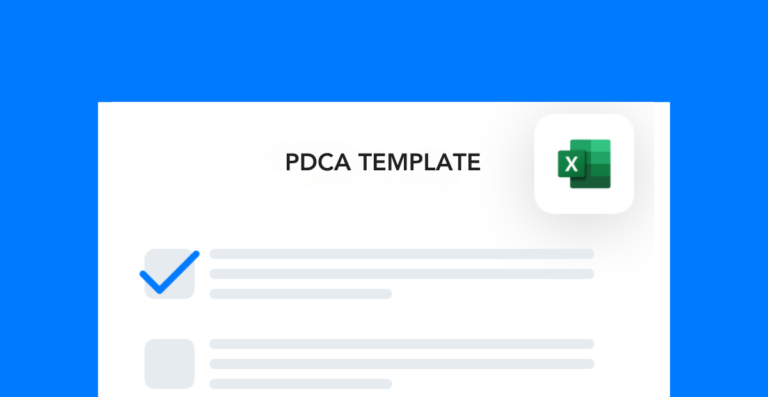Delivering consistent, high-quality products or services is the cornerstone of quality control. Your guide to excellence is a well-structured quality control checklist, ensuring that every aspect of your work aligns with the highest standards of quality. Effective quality control is the protector of your brand’s reputation and a driver of customer satisfaction.
As you create your checklist, remember that it signifies your organization’s commitment to delivering excellence. It’s not about checking boxes; but a mindset of quality at every level and in every process. Our comprehensive guide will help you create a tailored quality control checklist, applicable across many different industries.
Free template!
This PDCA Excel template will walk you through the cycle for an effective review.
Define your quality control goals
Begin by clearly defining the purpose and scope of your quality control checklist. What is it you want to achieve through quality control? What products or services will it cover? Understanding the scope will help stay focused and ensure your checklist aligns with your organization’s goals.
Industry standards and stakeholders
Before diving into checklist creation, research and compile industry-specific standards and regulations that apply to your products or services. These standards are not only essential for meeting legal requirements but also great for industry best practices.
Quality control also involves multiple stakeholders, from production teams to quality assurance professionals and even customers. Name all relevant parties and define their roles and responsibilities within the quality control process. Effective communication among stakeholders is critical to successful quality control.
Inspection points and quality metrics
Identify the inspection points within your production or service delivery process. These points stand for critical stages where quality control checks are necessary. Breaking down the entire process into manageable steps ensures that each step aligns with your goals.
For each inspection point, find the quality metrics or parameters that must be measured and checked. These metrics should directly relate to the desired quality outcomes and industry standards. Common quality metrics include accuracy, precision, consistency, reliability, and compliance with regulations.
Tolerance limits and checkpoints
Establish tolerance limits for each quality metric. These limits define the acceptable range within which a particular metric should fall. Industry standards, customer expectations, and internal quality goals all help set tolerance limits.
Develop detailed checkpoints for each inspection point. These checkpoints should clearly tell what needs to be checked, how it will be checked, and who handles the check. Ensuring clarity and consistency in your checkpoints is crucial for effective quality control.
Competency and corrective action
Individuals responsible for conducting quality control checks should have adequate training and competency in their roles. Include training requirements and competency assessments within your checklist to keep a high level of ability among your team.
Prepare a list of corrective actions to be taken when quality control checks reveal deviations or non-conformance. Each corrective action should be specific, doable, and linked to the identified quality issues. Establish protocols for reporting, documenting, and implementing corrective actions.
Continuous improvement and validation
Quality control checklists shouldn’t remain static. Establish a regular review process to assess the checklist’s effectiveness and relevance. Continuously seek feedback from stakeholders and incorporate improvements based on lessons learned and evolving industry best practices.
Before completing your quality control checklist, go through a validation and verification processes. Validation will ensure that your checklist is achieving its purpose, while verification will confirm that it aligns with the quality goals and standards you’ve set.
We’ve laid out that creating an effective quality control checklist is a detailed process. Implementing the strategies and steps discussed in our guide will help you craft a quality control checklist that will not only meet but consistently exceed the highest standards of quality assurance.
Other posts you might like…
No posts


